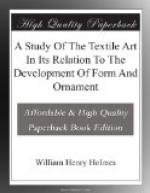[Illustration: FIG. 345. Figure of a bird painted upon a Zuni shield, free hand delineation.]
Now, it may be further observed that had the figure been placed at one side of the center, extending only from the border to the middle of the tray, an entirely different result would have been reached; but this is better illustrated in a series of bird delineations presented in the following figures. With many tribes the bird is an object of superstitious interest and is introduced freely into all art products suitable for its delineation. It is drawn upon walls, skins, pottery, and various utensils and weapons, especially those directly connected with ceremonies in which the mythical bird is an important factor. The bird form was probably in familiar use long before it was employed in the decoration of basketry. In Fig. 345 I present an ordinary graphic representation. It is copied from a Zuni shield and is the device of an order or the totem of a clan. The style is quite conventional, as a result of the various constraints surrounding its production. But what a strange metamorphosis takes place when it is presented in the basketmaker’s language. Observe the conventional pattern shown upon the surface of a Moki tray (Fig. 346). We have difficulty in recognizing the bird at all, although the conception is identical with the preceding. The positions of the head and legs and the expanded wings and tail correspond as closely as possible, but delineation is hampered by technique. The peculiar construction barely permits the presentation of a recognizable life form, and permits it in a particular way, which will be understood by a comparison with the treatment of the human figure in Fig. 344. In that case the interlaced combination gives relievo results, characterized by wide, radiating ribs and narrow, inconspicuous, concentric lines, which cross the ribs in long steps. The power of expression lies almost wholly with the concentric series, and detail must in a great measure follow the concentric lines. In the present case (Fig. 346) this is reversed and lines employed in expressing forms are radiate.
[Illustration: FIG. 346. Figure of a bird executed in a coiled Moki tray, textile delineation.]
The precise effect of this difference of construction upon a particular feature may be shown by the introduction of another illustration. In Fig. 347 we have a bird woven in a basket of the interlaced style. We see with what ease the long sharp bill and the slender tongue (shown by a red filament between the two dark mandibles) are expressed. In the other case the construction is such that the bill, if extended in the normal direction, is broad and square at the end, and the tongue, instead of lying between the mandibles, must run across the bill, totally at variance with the truth; in this case the tongue is so represented, the light vertical band seen in the cut being a yellow stripe. It will be seen that the two representations are very unlike each other, not because of differences in the conception and not wholly on account of the style of weaving, but rather because the artist chose to extend one across the whole surface of the utensil and to confine the other to one side of the center.




